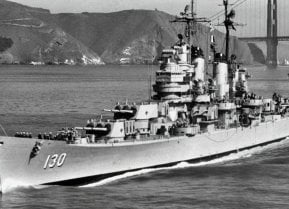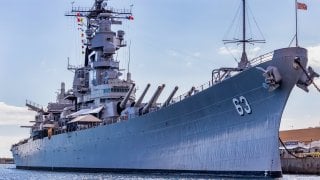What Was the Worst U.S. Navy Battleship Ever?
The USS Massachusetts (BB-2), commissioned in 1896, is often considered the worst battleship in U.S. Navy history due to its numerous design flaws and operational issues. This Indiana-class battleship suffered from severe stability problems, making it difficult for the crew to operate its guns effectively.
Summary and Key Points: The USS Massachusetts (BB-2), commissioned in 1896, is often considered the worst battleship in U.S. Navy history due to its numerous design flaws and operational issues. This Indiana-class battleship (as seen below) suffered from severe stability problems, making it difficult for the crew to operate its guns effectively.

-Its propulsion system was unreliable, frequently breaking down and requiring repairs. The ship's armament, including four 13-inch guns, was poorly balanced, causing it to list severely when fired.
-Despite participating in notable actions during the Spanish-American War and the Boxer Rebellion, the USS Massachusetts' fundamental design flaws rendered it largely ineffective in combat, earning it a dubious place in naval history.
The USS Massachusetts (BB-2) is the Worst US Navy Battleship Ever
For decades, the U.S. Navy billed itself as holding the greatest battleship fleet in the world. Indeed, before the events of the Pacific Theater of the Second World War, the American Navy could lean heavily on its marvelous designs for battleships, as well as its industrial capacity to produce those battleships.
But even great navies miss their mark every so often. One such missed mark for the U.S. Navy’s battleship design and engineering team was USS Massachusetts (BB-2).
Some Facts and Figures
Commissioned in 1896, this Indiana-class battleship stands out as one of the most poorly designed and underperforming battleships in the history of the Navy. The vessel suffered from a series of design flaws and operational issues that left it ineffective in combat. Despite these facts, it had a relatively long history, serving in the Spanish-American War and being a key part of the international fleet that was assembled to respond to the Boxer Rebellion in colonial China.
One of the most significant problems with USS Massachusetts was its lack of stability. The ship’s hull was not properly balanced. It had a tendency to roll excessively even in moderate seas. Under these conditions, the crew had difficulty operating the ship’s guns effectively, as the constant rolling often made it nearly impossible to aim accurately.
A battleship that is fundamentally incapable of targeting its enemies seems like a pretty bad battleship, if you ask me!
Another major flaw in the design of Massachusetts was its propulsion system. Equipped with two vertical, triple-expansion steam engines, these systems were prone to breakdowns and malfunctions. This meant that the ship often had difficulty maintaining its top speed, and it was frequently forced to return to port for repairs.
In terms of armaments, USS Massachusetts was equipped with four 13-inch guns, which were the largest guns available at the time of its construction. Again, though, there were balancing issues, this time with the guns themselves. And because these guns were improperly balanced, the weight of these weapons caused the ship to list severely when they were fired.
Bottom line: Massachusetts was an incredibly unreliable weapons platform in combat.
This boat had a displacement of 10,288 long tons and was not only equipped with 13-inch guns, but also had eight 8-inch guns, four 6-inch guns, twenty 6-pounders, six 1-pounders, and two 18-inch torpedo tubes. Massachusetts had a length of 350 feet, 11 inches, and a beam of 69 feet, 3 inches, as well as a draft of 27 feet. She had a top cruising speed of 15 knots, or 17 miles per hour, and carried a complement of 473 officers and men.
Her Service Record
The ship saw action during the Spanish-American War that proved to be historic. On May 31, 1898, USS Massachusetts along with USS Iowa (BB-4) and USS New Orleans, bombarded forts at the entrance to Santiago de Cuba. They also engaged the Spanish cruiser Cristobal Colon, forcing it to retreat into Santiago’s inner harbor.
On July 4, 1898, Massachusetts returned to Santiago, Cuba, and helped USS Texas force the Spanish cruiser Reina Mercedes to beach and surrender.
These actions were part of larger naval operations during the Spanish-American War that saw the U.S. Navy successfully blockade the Spanish fleet in Santiago and ultimately secure victory in the conflict.
A couple of years later, during the Boxer Rebellion in colonial China, USS Massachusetts was deployed as part of an international naval force to protect foreign interests and to relieve the siege of the Legation Quarter in Beijing. On June 17, 1900, Massachusetts, along with other American ships, was ordered to proceed to Taku, China, to support the international relief expedition.
The Worst Battleship in US History
Despite this service, Massachusetts stands out as one of the worst-designed and worst-performing battleships in the history of the United States Navy. Its numerous flaws, including its lack of stability, unreliable propulsion system, and poorly balanced armament, rendered it largely ineffective in combat.
Author Experience and Expertise: Brandon J. Weichert
Brandon J. Weichert, a National Interest national security analyst, is a former Congressional staffer and geopolitical analyst who is a contributor at The Washington Times, the Asia Times, and The-Pipeline. He is the author of Winning Space: How America Remains a Superpower, Biohacked: China’s Race to Control Life, and The Shadow War: Iran’s Quest for Supremacy. His next book, A Disaster of Our Own Making: How the West Lost Ukraine, is due October 22 from Encounter Books. Weichert can be followed via Twitter @WeTheBrandon.
All images are Creative Commons or Shutterstock.
From the Vault
Russia Freaked Out: Why the U.S. Navy 'Unretired' the Iowa-Class Battleships
Battleship vs. Battlecruiser: Iowa-Class vs. Russia's Kirov-Class (Who Wins?)


